Strawberry (Fragaria vesca) is an important fruit crop, and its commercial production is possible in the temperate and sub-tropical regions of the country. Growing Strawberry plants is not difficult at all. But to get the best yield from your plants, you need to pay attention to some elements like choosing the suitable variety for your area and your needs, planting at the right time, and providing the right conditions for growth.
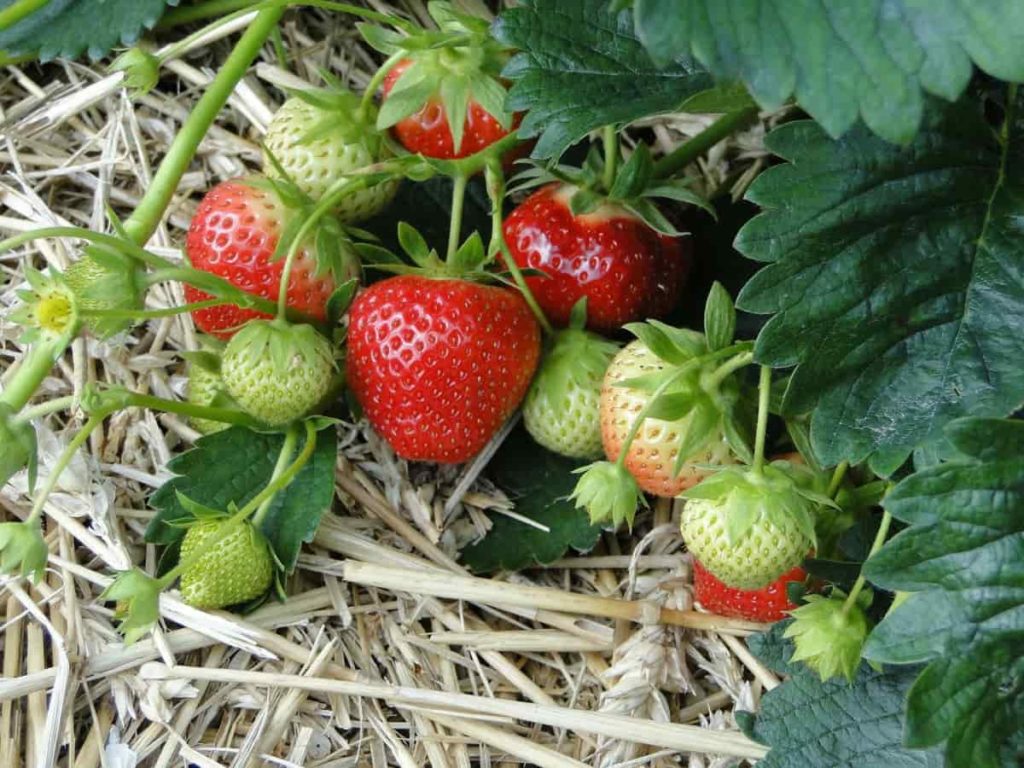
Given the local market conditions, choosing an appropriate growth system that ensures good production and profitability is essential. Protected crop cultivation will help maximize yields by maintaining suitable growing temperatures, promoting maturity, and prolonged harvest. You can increase Strawberry yield depending on variety selection, farming method, pest management, and fertilizer application. Let’s discuss the top 20 Steps to Boost Strawberry yield.
Top 20 steps to boost Strawberry yield
Step 1: Select high yield varieties
The main Strawberry varieties are Chandler, Local Jeolikot, Dilpasand, Bangalore, Tioga, Torrey, Selva, Belrubi, Fern, Pajaro, Premier, Red cost, Florida 90, Katrain Sweet, Pusa Early Dwarf & Blakemore. Other high yielding varieties are;
- Darselect – It is a large-fruited, high-yielding variety.
- Earliglow – It is an early berry of high quality.
- Elsanta – It is one of the most widely used varieties in Northern Europe. It has high productivity, and its fruit is strong and fragrant.
Step 2: Planting season affected crop yield
September-October is the best time to plant runners or crowns in hilly areas. If the plants are planted too early, the plant does not have strength, and fruit yield and quality decrease. If planted too late, runners are ready in March and lighter crops. Runners are uprooted from the nursery, bundled, and produced in the field. They can be kept in cold storage before transplanting. The soil should be irrigated frequently to reduce the water pressure in the leaf. Defoliation inhibits plant growth, delays fruit set, and reduces yield and quality.
Step 3: Soil requirement for fruit growth
Plant your Strawberries in sandy, well-drained soil. Too much water can rot the crown of Strawberry plants. It will not only restrict the fruit but can also kill the Strawberry plants. Strawberries grow best in slightly acid-neutral soils with a pH of about 5.5 to 7.0. If the soil is very acidic, you can add lime to increase the pH level. Put an inch of rotted manure or layer of compost in the sandy soil. Work composted leaves into clay soil.
In case you miss this: How To Start Strawberry Gardening, Tips, Ideas
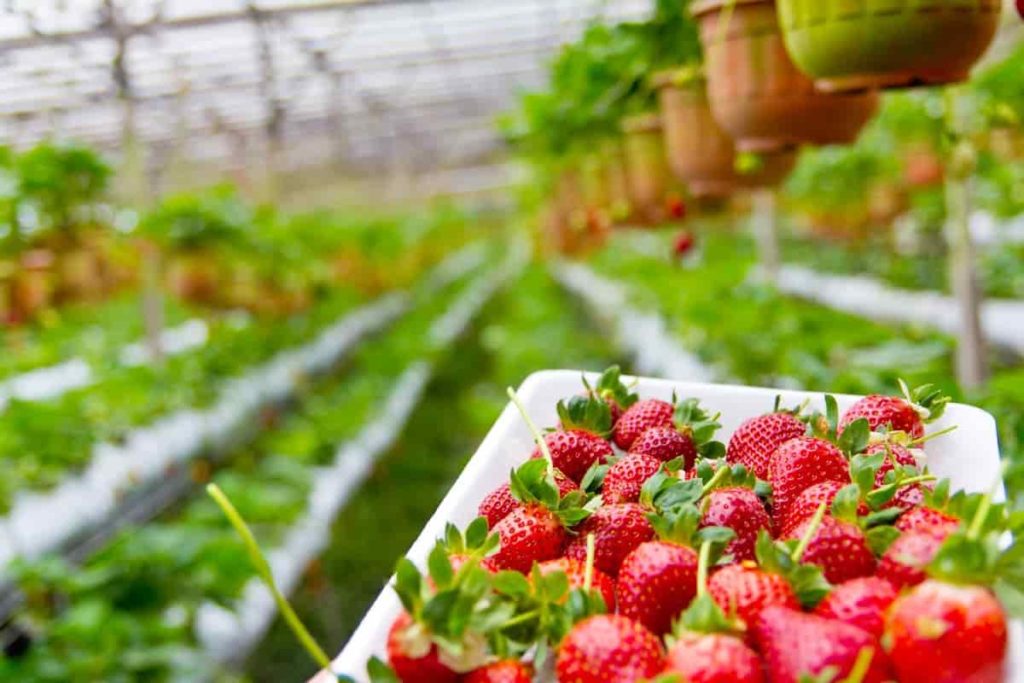
Step 4: Growth regulators for improving fruit size
Spray GA3 (50 ppm) four days after flowering and spray maleic hydrazide (0.1-0.3%) to increase yield by 31-41%. In addition, Morphactin (@ 50 ppm) improves fruit size.
Step 5: Tips for producing more berries
Trim the Strawberry runners to produce more beers. Every year your Strawberry plant has runners. Runners are long stems that grow out of the main plant and make more Strawberry plants. These runners will connect closely and form a new plant but stick to the main plant and extract nutrients from it. It can eliminate the main plant and produce more berries, leading to a “rest period.”
Step 6: Proper spacing helps increase plant growth
Adequate space is enough for Strawberry plants to grow. Plants should be at least 12 inches (31 cm) apart. Overcrowded plants have a higher risk of producing small yields of sour Strawberries.
Step 7: Keep your Strawberry plants healthy
Make sure Strawberry plants are free from pests and diseases. Plants fighting disease or parasites will not have much energy to produce flowers and berries. To keep your Strawberry plants healthy, deal with pests and diseases as soon as you see them.
Step 8: Nitrogen nutrition for the high yield
Nitrogen is essential for plants’ growth, one of the critical building blocks of protein. It is necessary for biomass and fruit production, with maximum photosynthetic integration leading to higher Strawberry yields. Nitrogen time is also significant, and programs need to be developed to provide adequate leaf growth and healthy fruit sets without causing problems during fruit filling and harvesting.
It would mean focusing on nitrogen use in the fall and early spring – to strengthen and build the plant and improve fruit production. These nitrogen applications should be balanced with the expected emission of nitrogen from any organic matter in the soil in preparation for planting Strawberries.
Step 9: Before fertilizing Strawberry plants
Strawberries are flexible and can grow in different settings. In addition to feeding Strawberry plants, there are other tasks to ensure healthy plants that provide the highest yields. These plants need a lot of nitrogen in early spring and late autumn because they send runners and produce berries. Ideally, you have prepared the soil by modifying it with manure or compost before planting berries. It will enable you to reduce or eliminate the plants’ extra fertilizer.
In case you miss this: Strawberry Farming Project Report, Cost, Profit Guide
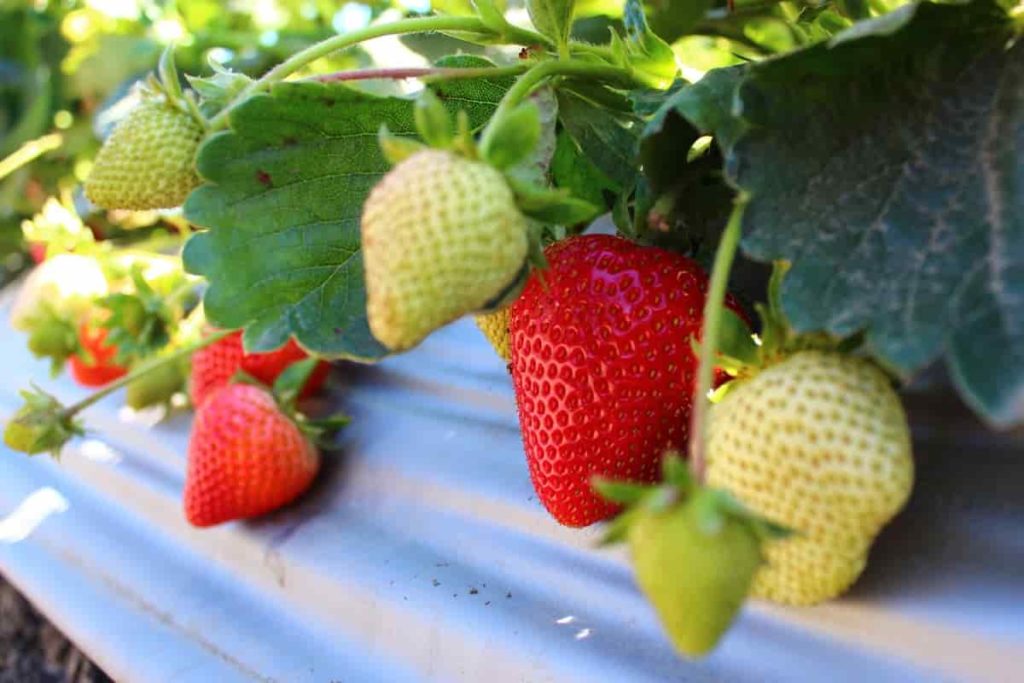
Feed your Strawberries the correct type of food – Strawberries will not grow well without nutrients. If plants are given too much nitrogen, they will grow too many plants without flowers. Regular watering and feeding with an NPK ratio of about 10-10-10 ensure healthy growth. In addition, high potassium-low nitrogen fertilizers help increase crop yields.
Step 10: Increase Strawberry yield in PVC pipes
You can grow Strawberries in PVC pipes to get a high yield. PVC pipes are non-toxic; the most common uses are plumbing and drainage. PVC is cheap, and you can cut the pipe to the length you want. You can water the plants in the upper half of the PVC pipe through the upper part of the planter. It is best to cut a 1-inch diameter pipe a few inches longer than the pipe that serves as your planter.
To continuously increase the production of Strawberries in PVC pipes, you need to keep the proper spacing between each plant. To grow your plants and increase the yield of Strawberries in PVC, you need to choose a one-day neutral variety of strawberries. The main reason for this is the production of runners, which is not as high as for the June varieties. Day-neutral Strawberries varieties produce fewer runners than June-bearing plants and perform better in containers.
Step 11: Grow Strawberries in hydroponics to get more yield
Many hydroponic methods are available for Strawberry crops, which are responsible for the most extensive product range in the berry range. Hydroponics can help you grow tasty and large Strawberries. A greenhouse is the best way to grow Strawberries. Cultivating Strawberries in a safe environment reduces the growth of pests and plant diseases. Also, the hydroponic system allows the plant to have maximum control over the number of nutrients it needs. Ultimately, it helps improve resources, creating significant savings.
Step 12: Crop nutrition for getting more Strawberry yield
- Nitrogen is essential for fruit growth and green leaf production, promoting the plant growth process and protein assimilation.
- Potassium promotes strong growth and improves water regulation, stress tolerance, and transport/storage processes inside the plant.
- Phosphorus provides energy to the plant and is especially important for root growth, flower induction, and high fruit set.
- Sulfur, iron, and other micronutrients increase plant growth and accumulation of dry matter in fruits.
- Magnesium increases photosynthesis as a result of increasing plant chlorophyll.
- Calcium ensures good potency of plants and fruits, protects the production of roots, leaves, and stalks, and promotes yield.
- Boron is required for a good fruit set and pollen germination, which increases the number of fruits and improves the weight of the fruit.
- Zinc is needed for new tissue growth and development.
In case you miss this: Strawberry Farming; Planting; Growing; Care; Harvesting
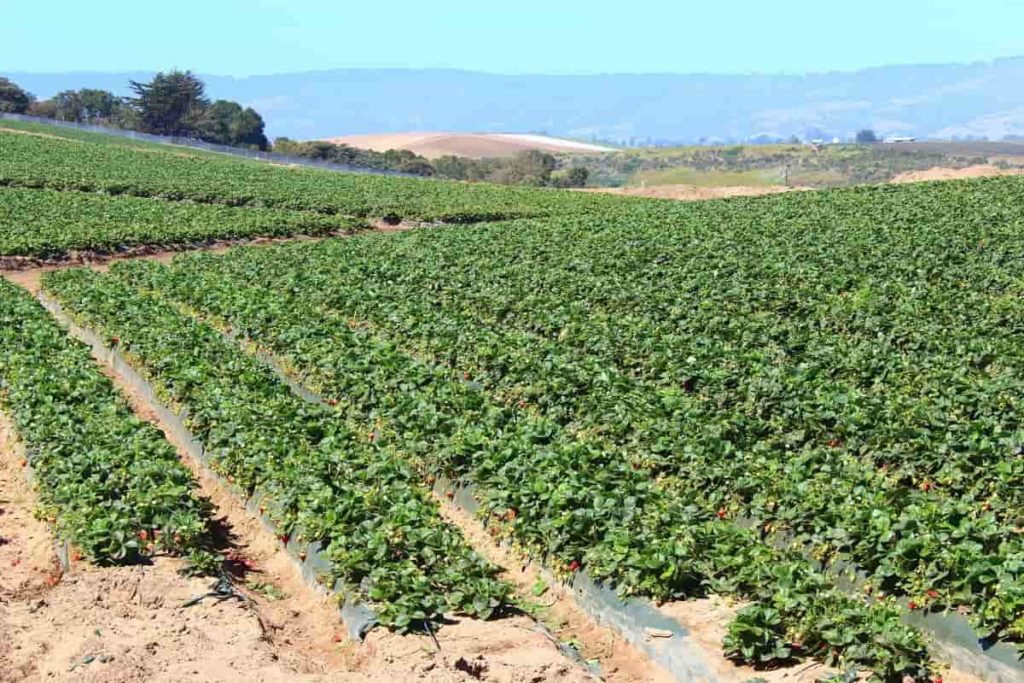
Step 13: Organic practices will improve crop yield
Strawberry plants grown on organic farms produce high-quality fruit and have healthier soil than traditionally grown plants. If you are dedicated to growing fruits organically, introduce aged manure to increase nitrogen. Do not use fresh manure. For fertilizing Strawberries, organic options include blood meal containing 13% nitrogen, fish meal, soy meal, or alfalfa meal. Also, feather meal can increase nitrogen levels, but it is released very slowly.
Feed with all-natural household fertilizers (a weekly handful of leftover filter coffee grinds can work wonders) and water regularly to stimulate blossoming. Do not overwater the shallow roots too much; they need water in hot weather, but they do not want to get wet. You will soon see small green Strawberries, which will indicate that the fruit is ‘set.’
Step 14: Why does Strawberry taste so bitter?
The taste of most fruits is affected by the weather. As for Strawberries, hot sunny weather produces the most delicious fruit. When the weather is very hot, the taste of berries can be a little bitter. When the weather is cold and cloudy, Strawberry plants produce less sugar. A fungal disease causes leather rot, can be a problem in wet weather. Affected fruits have a leathery texture and a bitter taste.
Step 15: Mulching of Strawberries
It is an essential process in Strawberry farming. It is necessary because mulching helps the Strawberry plants avoid frost and control the temperature. Strawberry plants need to be mulched once or twice a year. At the same time, the row or bed you put on should be mulched with straw, old leaves, pine needles, or some other organic matter throughout the year. It also helps control weeds and retains moisture.
Step 16: Solutions for Strawberry plant dying
The causes of dying Strawberry plants dying lacking nutrients in the soil, frost damage, crown rot, or drought stress due to low water, which causes the plant leaves to wilt then turn a brown color. Strawberry leaves turn yellow and die again in response to over-watering and crown rot. Dying Strawberry plants is usually due to a lack of water.
In case you miss this: District Wise Crop Production in Andhra Pradesh: Major Crops in Andra Pradesh
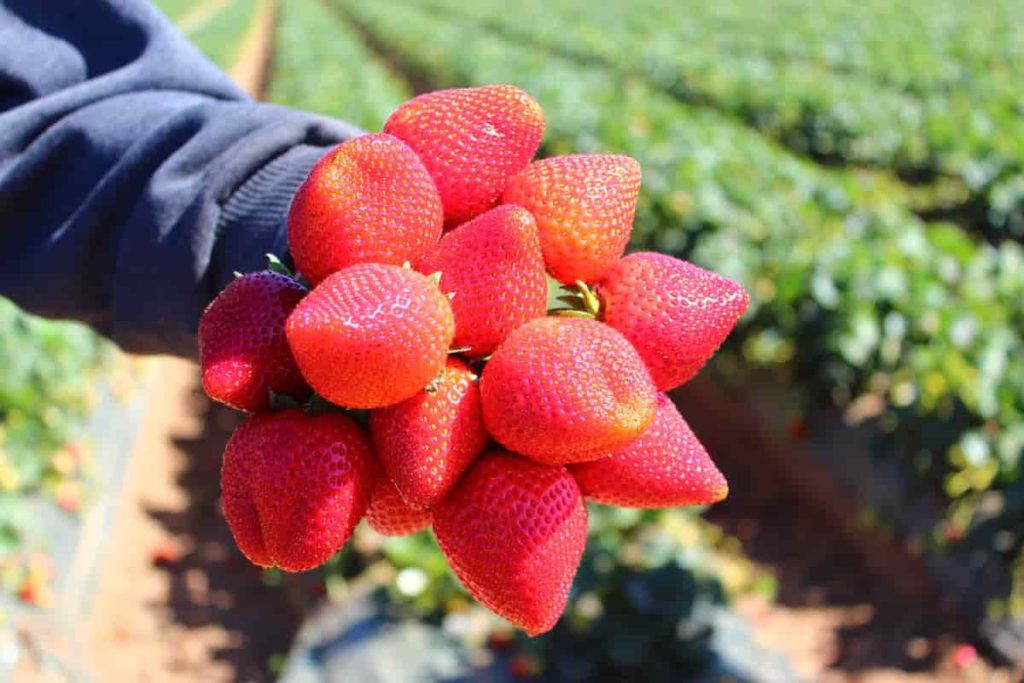
If the soil is not moist while the roots of the Strawberry plant are forming, the leaves lose a lot of moisture, which causes the leaves to wither and turn brown, resulting in the death of the Strawberry plant. Prevention is vital, so constantly water the Strawberry plants regularly, not to prevent the disease from developing later. Strawberry plants planted at the proper depth in well-drained soil have a much lower risk of crown rot.
Step 17: Strawberry fruit dropping
When the weather gets too cold, the plants fall off to maintain proper cellular function. Fortunately, Strawberry plants recognize this temperature change and will become inactive rather than die, as most annual plants do. However, the young fruit should be thinned before the tree drops to prevent the fruit from falling due to overgrowth.
Step 18: Encourage Strawberries to fruit and increases berry size
Strawberries bloom and bear fruit in the autumn and winter months from October to February. It would help if you took care of your plants during the summer. Strawberry plants will continue to grow for at least another 2-3 years before they need to be replaced. Cut old leaves from June plants for next year, careful not to damage the plant’s central stalk (crown).
Ever-bearers don’t always have to trim. Frost protection measures to protect the flowers will ensure good fruit growth and a strong fruit set. A good water supply, especially during flowering and fruiting, keeps berry numbers and increases berry size.
Step 19: Control crop pests and diseases
Your plants may have sowbugs, spider mites, slugs, weevils, snails, and earwigs. When planting Strawberries, you need to cover the soil with a porous weed block material. When dealing with weevils, you can use diatomaceous earth for slugs or horticultural oils. Trapping some birds can also help keep birds away. When you plant your Strawberries, you need to know that several diseases can affect them. Your Strawberry plant can be affected by leaf spot, leaf blight, verticillium wilt, and powdery mildew.
To reduce them, choose the right place to plant Strawberries. You want your new plant in areas with full sun and soil well-drained to minimize disease. To increase air circulation, keep the rows tight. Keep weeds away from Strawberry plants. Your growing Strawberries do not need to be watered at night. When you wet the leaves in the cool night air, you only create a breeding ground for fungi and many diseases.
In case you miss this: Top 20 Vertical Farming Companies in India: Best List
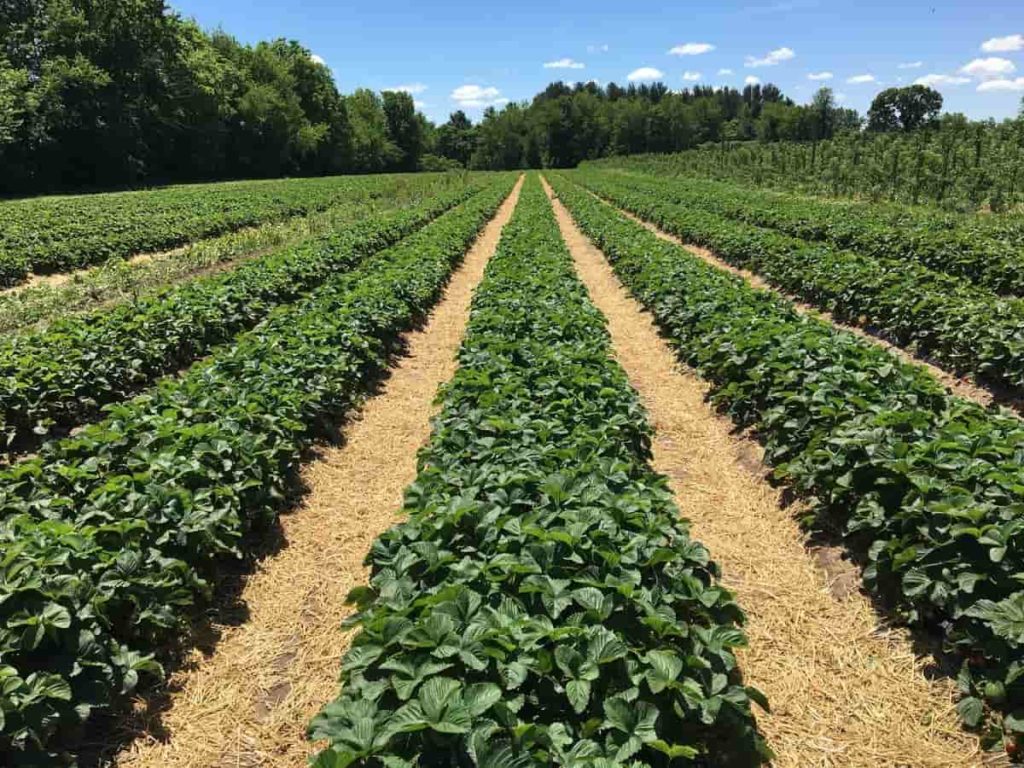
Step 20: Harvesting tips for developing healthy berries
Harvest ripe Strawberries to encourage unripe or newly set berries to grow bigger. Check the plants every other day, pick all mature, completely red berries. At the same time, choose any damaged, weak, or rotting berries from the plants to divert the plant’s energy towards developing healthy berries.
- Economical Aquaculture: A Guide to Low-Budget Fish Farming
- 15 Common Planting Errors That Can Doom Your Fruit Trees
- How to Make Houseplants Bushy: Effective Tips and Ideas
- Innovative Strategies for Boosting Coconut Pollination and Yield
- Pollination Strategies for Maximum Pumpkin Yield
- The Complete Guide to Chicken Fattening: Strategies for Maximum Growth
- Natural Solutions for Tulip Problems: 100% Effective Remedies for Leaf and Bulb-Related Issues
- Revolutionizing Citrus Preservation: Towards a Healthier, Greener Future
- Natural Solutions for Peony Leaf and Flower Problems: 100% Effective Remedies
- Maximizing Profits with Avocado Contract Farming in India: A Comprehensive Guide
- Natural Solutions for Hydrangea Problems: 100% Effective Remedies for Leaf and Flowers
- The Ultimate Guide to Choosing the Perfect Foliage Friend: Bringing Life Indoors
- From Sunlight to Sustainability: 15 Ways to Use Solar Technology in Agriculture
- The Ultimate Guide to Dong Tao Chicken: Exploring from History to Raising
- The Eco-Friendly Makeover: How to Convert Your Unused Swimming Pool into a Fish Pond
- Mastering the Art of Delaware Chicken Farming: Essentials for Healthy Backyard Flocks
- 20 Best Homemade Fertilizers for Money Plant: DIY Recipes and Application Methods
- How to Craft a Comprehensive Free-Range Chicken Farming Business Plan
- Brighten Your Flock: Raising Easter Egger Chickens for Beauty and Bounty
- How to Optimize Your Poultry Egg Farm Business Plan with These Strategies
- Subsidy for Spirulina Cultivation: How Indian Government Schemes Encouraging Spirulina Farmers
- Ultimate Guide to Raising Dominique Chickens: Breeding, Feeding, Egg-Production, and Care
- Mastering the Art of Raising Jersey Giant Chickens: Care, Feeding, and More
- Ultimate Guide to Raising Legbar Chickens: Breeding, Farming Practices, Diet, Egg-Production
- How to Raise Welsummer Chickens: A Comprehensive Guide for Beginners
- How to Protect Indoor Plants in Winter: A Comprehensive Guide
- Ultimate Guide to Grow Bag Gardening: Tips, Tricks, and Planting Ideas for Urban Gardeners
- Guide to Lotus Cultivation: How to Propagate, Plant, Grow, Care, Cost, and Profit
- Agriculture Drone Subsidy Scheme: Government Kisan Subsidy, License, and How to Apply Online
- Ultimate Guide to Raising Araucana Chickens: Breed Profile, Farming Economics, Diet, and Care
- Bringing Hydroponics to Classroom: Importance, Benefits of Learning for School Students
- Ultimate Guide to Raising Polish Chickens: Breed Profile, Farming Economics, Diet, and Care
- Ultimate Guide to Raising Australorp Chickens: Profile, Farming Economics, Egg Production, Diet, and Care
- Silkie Chicken Farming: Raising Practices, Varieties, Egg Production, Diet, and Care
- Sussex Chicken Farming: Raising Practices, Varieties, Egg Production, Diet and Care
- Homemade Feed Formulations for Livestock: Discover Cost-effective Starter to Finisher Feed Recipes